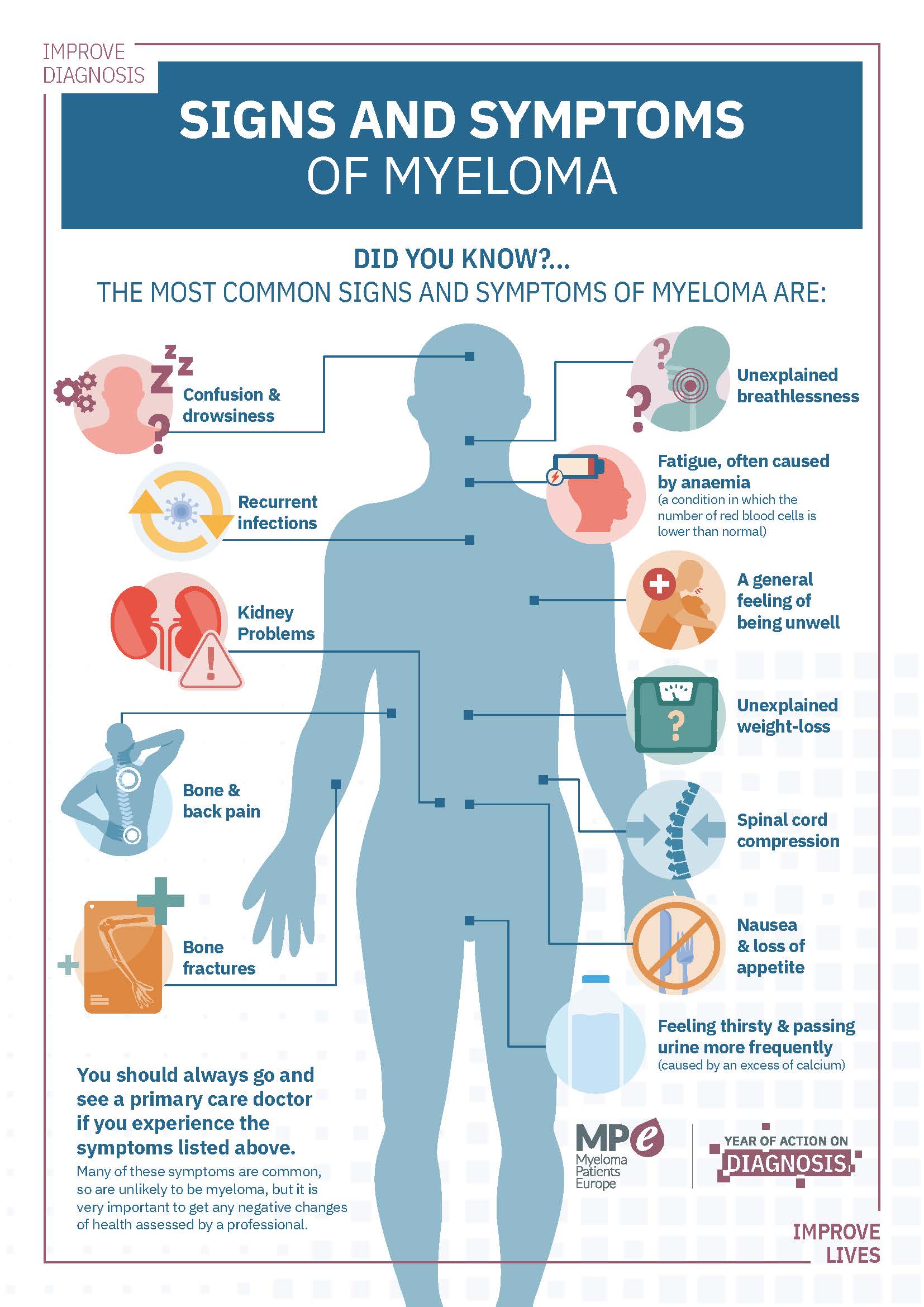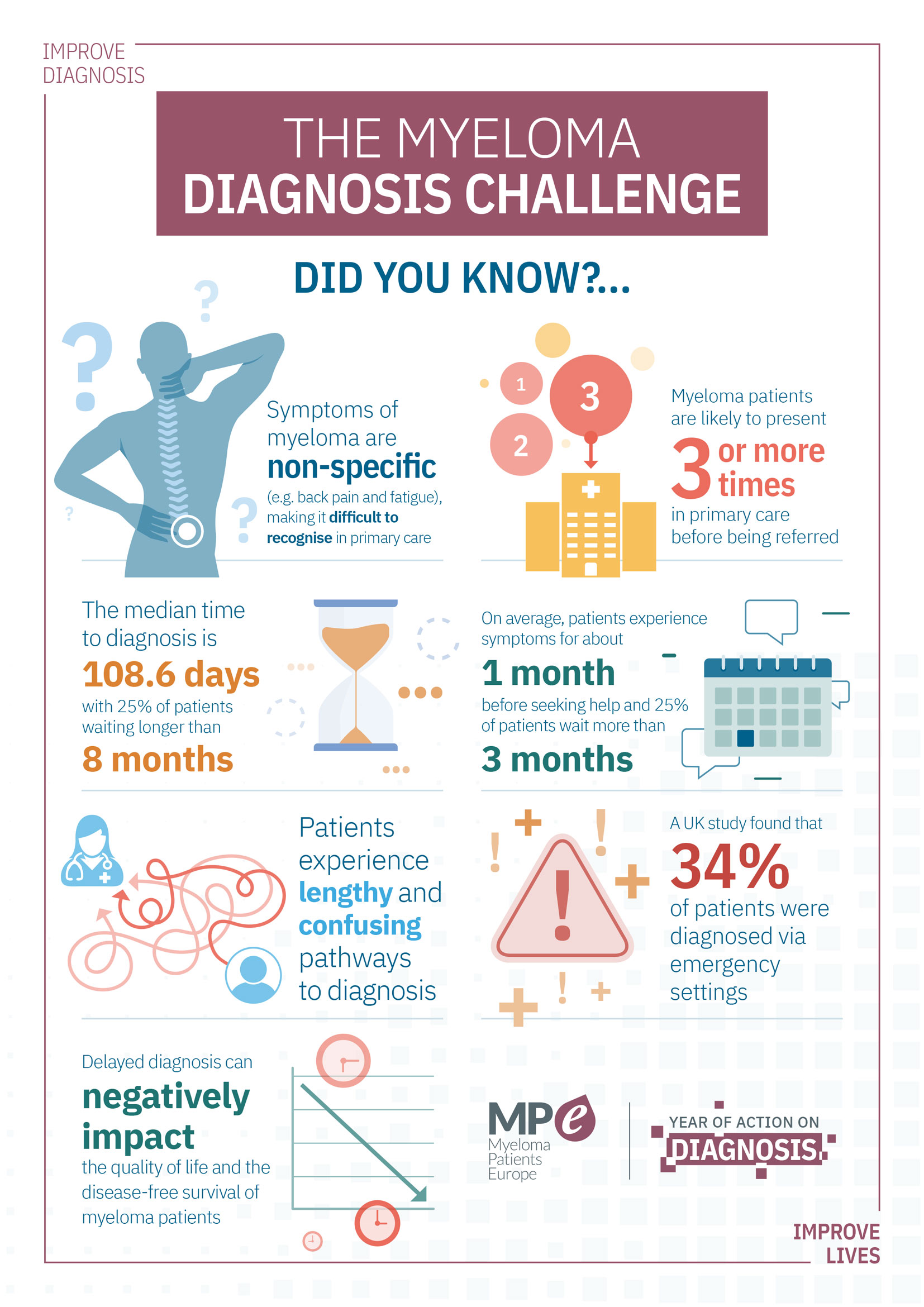Multiple Myeloma Information
Background, symptoms, treatment information & facts.Background
What is myeloma?
Myeloma, also known as multiple myeloma, is a cancer arising from plasma cells, a type of white blood cell which is made in the bone marrow. Bone marrow is the ‘spongy’ material found in the centre of the larger bones in the body. The bone marrow is where all blood cells are made.
Plasma cells form part of your immune system. Normal plasma cells produce antibodies, also called immunoglobulins, to help fight infection. In myeloma, these plasma cells become abnormal, multiply uncontrollably and release only one type of antibody – known as paraprotein or M protein ( Monoclonal protein) – which has no useful function. It is often through the measurement of this paraprotein/ M protein that myeloma is diagnosed and monitored.
Myeloma affects multiple places in the body (hence ‘multiple’ myeloma) where bone marrow is normally active in an adult i.e. within the bones of the spine, skull, pelvis, the rib cage, long bones of the arms and legs and the areas around the shoulders and hips. Myeloma is a relapsing-remitting cancer. This means there are periods when the myeloma is causing symptoms and/or complications and needs to be treated, followed by periods of remission or plateau where the myeloma does not cause symptoms and does not require treatment.
Source: myeloma.org.uk / Irish cancer society / NCCP
I am newly diagnosed
A diagnosis of myeloma can affect everyone differently. To begin with, most people have not heard of myeloma before receiving their diagnosis. This can make an already difficult situation all the more confusing and scary.
Being diagnosed with cancer can be a huge shock, even if your doctors have prepared you for this possibility. Patients and their families can feel overwhelmed, numb and can also experience a great deal of fear, anger and frustration. For other patients it comes as a relief that they finally have an answer to why they have felt so poorly for so long. All these feelings are common and are a natural part of coming to terms with a diagnosis.
There are several immediate questions you may have. The following resources and services may help to support you in the first few weeks and months, and beyond.
There are many resources you can link in with:
- Patient information pack: Which you receive when first diagnosed with multiple myeloma. The pack focuses on what you need to know following your diagnosis and provides some practical tips for the weeks and months ahead. Your family members and friends may also find it useful to read.
- Clinical Nurse Specialists: are specialised nurses trained to provide support to patients and their families from the time of diagnosis and through out there treatment journey
- Psychologist: Are available in some hospitals and provide psychological care to help you cope during your treatment journey
- Social worker: Can provide support and advice on benefits and entitlements and can help to link you with “Care to drive “ a facility free to some patients who have transport difficulties
- There are many information booklets such as “understanding Myeloma” provided by the Irish cancer society which provide information on treatment, physiscal, psychological and social aspect of Multiple Myeloma.
Someone I know has myeloma
A diagnosis of myeloma can bring significant change, uncertainty and concern for patients, their families and friends. Despite these challenges, patients do seem to cope; they get on with their lives, despite the ups and downs. Very often patients are supported by carers or family members who play a significant role in helping them to manage and maintain a good quality of life.
Caring for a loved one can bring great personal satisfaction, but there can also be times when it’s tiring, frustrating and isolating. Becoming more knowledgeable about myeloma, its treatment options and potential complications can help carers and family members to support patients to make informed decisions about their treatment, care and life choices.
If you know someone who has been diagnosed with myeloma, the following resources have been developed with you in mind. We encourage you to call, email, if you have any questions or would appreciate the opportunity to talk to someone who knows about myeloma.
Other resources include:
- Irish cancer society
- Daffodil Centre
- Myeloma support groups
Source: myeloma.org.uk / Irish cancer society
Symptoms & complications
Unlike many other cancers, myeloma can affect the body in several ways. Most of the symptoms related to myeloma are caused by the build-up of the abnormal plasma cells in the bone marrow and the presence of the paraprotein in the blood or in the urine.
Plasma cells produce immunoglobulins (antibodies), which is a key piece of immune function. In myeloma the immunoglobulin is mal functioning and build up can lead to the following symptoms.
NB – Multiple myeloma may be silent in the early stages and may not present with symptoms and be diagnosed on blood test.
The most common symptoms and complications include the following which your medical team may identify as the acronym CRAB-I
C Hypercalcaemia:
A condition in which the level of calcium in the blood is too high. It can occur as a result of myeloma bone disease and can cause thirst, nausea, vomiting, confusion and/or constipation
R Kidney damage:
Can be caused by the myeloma itself or as a side-effect of treatment
A Anaemia:
A reduction in the number of red blood cells. It can occur as a result of the myeloma or as a side-effect of treatment and can cause fatigue, weakness or breathlessness
B Bone disease/Pain
The middle or lower back, the rib cage and the hips are the most frequently affected places. The principle cause of pain for myeloma patients is myeloma bone disease. Effective control and management of pain is an important aspect of myeloma treatment
I Recurring infection:
Common in myeloma patients because the myeloma and its treatments interfere with the immune system
Other symptoms include
Fatigue:
Due to the myeloma itself, to one or more of its complications (e.g. anaemia), or it can be a side-effect of treatment
Peripheral neuropathy:
Damage to the nerves that make up the peripheral nervous system. It can be caused by the treatments for myeloma and also the myeloma itself
Not everyone will experience all or any of these. Supportive treatments are commonly used alongside and after anti-myeloma treatment to relieve, stabilise and in some cases, help prevent these symptoms and complications.
Source: myeloma.org.uk / Irish cancer society / NCCP
How is myeloma treated?
Treatment for myeloma is aimed at disease control by stopping the production of abnormal plasma cells –paraprotein/M band, relieving the complications and symptoms it causes, reducing risk of infection and promoting wellbeing and quality of life.and extending and improving the quality of patients’ lives. Myeloma treatment is almost always with a combination of drugs over periods of time known as cycles. Cycles may last from weeks to months.
Treatment combinations are usually made up of two or three different types of drugs which work well together and can include chemotherapy drugs (e.g Cyclophosphamide), steroids (e.g. dexamethasone and prednisolone), immunomodulatory agents to help normalize the immune system (e.g. Lenalidomide, Pomalidomide) and targeted therapy (e.g Bortezomib, Carfilzomib).d other types of anti-myeloma drugs (e.g. thalidomide, Velcade® and Revlimid®).
Initial treatment/Front line treatment
Commonly used initial treatment combinations for myeloma include:
- Bortezomib ( Velcade), Lenalidomide, Dexamethasone (known as VRD)
- Cyclophosphamide, Bortezomib, Dexamethasone (known as CyBorD)
- Lenalidomide, Dexamethasone
- Cyclophosphamide, thalidomide and dexamethasone (known as CTD)
- Melphalan, prednisolone and thalidomide (known as MPT)
- Velcade®, melphalan and prednisolone (known as VMP)
- After receiving an initial course of treatment, you may be suitable to go on and have high-dose therapy and a stem cell transplant.
Supportive care
You may also be prescribed other treatment to help prevent or manage potential side-effects of treatment combinations and treat the symptoms and complications of myeloma.
These include:
Bisphosphonates to help minimise myeloma bone disease, hypercalcaemia and bone pain
Pain-killers
Radiotherapy for areas of localised bone disease and pain
Blood transfusions and/or erythropoietin (EPO) for anaemia
Vaccination for ‘flu
Anti viral medication / preventative antibiotics
Intravenous immune globulins
Maintenance
To sustain a response from initial or front-line treatment you may or may not be prescribed myeloma treatments for a period of time.
Examples of these treatments include:
Lenalidomide
pomalidomide
Bortezomib
Treatment for relapsed myeloma
Myeloma is highly treatable in the majority of cases but unfortunately it is currently incurable. This means that even after successful treatment has given you a period of remission or stable disease, your myeloma will return. This is called a relapse. There are a number of effective treatments available for relapsing myeloma. This is true regardless of whether it is your first relapse or if you have experienced one or more relapses previously.
Commonly used treatment combinations at relapse include:
Carfilzomib / Lenalidomide/Dexamethasone (KRD)
Ixazomib/Lenalidomide/dexamethasone (IRD)
Lenalidomide/Dexamethasone (LD)
Pomalidomide/Dexamethasone (PD)
Daratumumab Monotherapy
Borte and dexamethasone
Revlimid® and dexamethasone
There are also a number of novel treatments being investigated for use in clinical trials.
Source: myeloma.org.uk/ Irish cancer Society/NCCP


